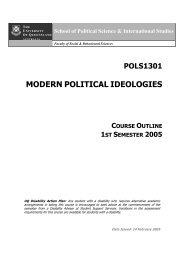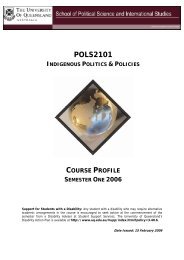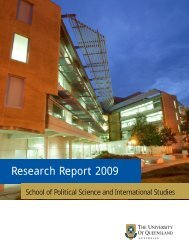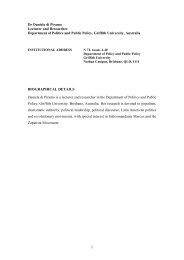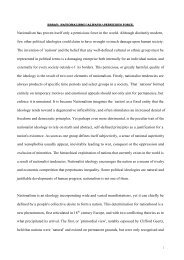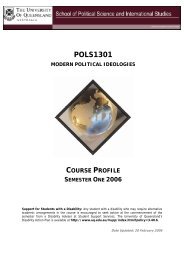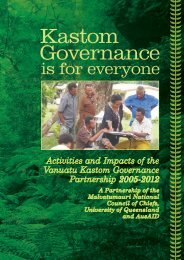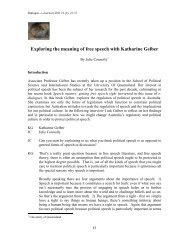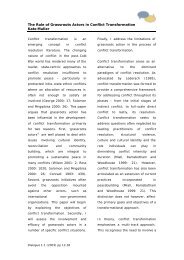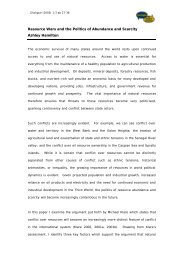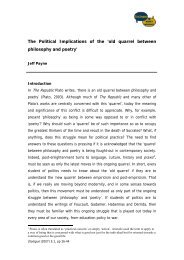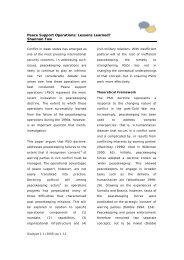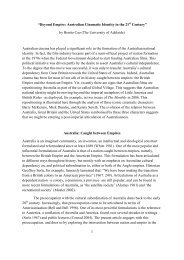CITATION GUIDE FOR CONTRIBUTORS TO DIALOGUE In ...
CITATION GUIDE FOR CONTRIBUTORS TO DIALOGUE In ...
CITATION GUIDE FOR CONTRIBUTORS TO DIALOGUE In ...
Create successful ePaper yourself
Turn your PDF publications into a flip-book with our unique Google optimized e-Paper software.
Footnotes are not used for the purpose of citations; however, they can be used sparingly to expand on points in<br />
the text. Notes should be numbered consecutively and placed at the end of the essay (‘endnotes’) or at the bottom<br />
of the page (‘footnotes’). The corresponding note number in the text should be typed as a superscript.<br />
REFERENCE LIST<br />
Citations in the body of the text refer to the more detailed Reference List, which should be placed at the end of your<br />
essay. The Reference List should provide an accurate, alphabetically sequenced and complete account of the<br />
sources you have consulted and/or cited in the essay.<br />
Reference lists should be presented in the following style:<br />
• List all references alphabetically by author’s surname. After the surname, list the full first name of the author<br />
(unless they are widely known only by their first initial).<br />
• After the author name/s, list the year of publication. Multiple publications by the same author should be listed in<br />
date order, with the earliest first. Where there are two or more publications by the same author in the same year,<br />
separate publications are indicated by lower-case letters: Cox, Gary 2002a. Cox, Gary. 2002b.<br />
• After the date of publication, list the title of the book or the name of the journal article followed by the title of the<br />
journal. The edition of a book should be indicated if it is not the first edition. Book and journal titles should be<br />
italicised or underlined. The name of journal articles should be placed in single quotation marks.<br />
• For books, the title is followed by the place of publication (use the city, not the suburb; for example, Brisbane, not<br />
St Lucia) and the name of the publisher. Cities which have obscure or common names may be followed by a country<br />
or state identifier (Cambridge, UK or Cambridge, MA).<br />
• For journal articles, the title of the journal is followed by the volume number, issue number (if any) and page<br />
numbers.<br />
EXAMPLES<br />
Here are some examples of how to correctly reference books, journals and other materials. Please take careful<br />
note of the placement of commas, full stops and colons.<br />
BOOKS<br />
Gorard, Stephen. 2003. Quantitative Methods in Social Science. London: Continuum.<br />
Baylis, John and Steve Smith, eds. 2005. The Globalization of World Politics: An <strong>In</strong>troduction to<br />
<strong>In</strong>ternational Relations, 3rd ed. Oxford: Oxford University Press.<br />
JOURNAL ARTICLES<br />
Mackenzie, Chris. 2004. ‘Policy Entrepreneurship in Australia: A Conceptual Review and Application’.<br />
Australian Journal of Political Science 39(2): 367-386.<br />
Walt, Stephen. 2005. ‘The Relationship between Theory and Policy in <strong>In</strong>ternational Relations’. Annual<br />
Review of Political Science 8: 23-48.<br />
PUBLICATIONS WITH MULTIPLE AUTHORS<br />
Citrin, Jack, Eric Schickler and John Sides. 2003. ‘What if Everyone Voted? Simulating the Impact of<br />
<strong>In</strong>creased Turnout in Senate Elections’. American Journal of Political Science 47(1): 75-91.<br />
Singleton, Gwynneth, Don Aitkin, Brian Jinks and John Warhurst. 2006. Australian Political <strong>In</strong>stitutions, 8th<br />
ed. Melbourne: Longman.<br />
EDITED BOOKS<br />
Galligan, Brian, ed. 1989. Australian Federalism. Melbourne: Longman Cheshire.<br />
Ward, Ian and Randall Stewart, eds. 2006. Politics One, 3rd ed. Melbourne: Palgrave Macmillan.<br />
CHAPTER IN AN EDITED BOOK<br />
Beeson, Mark and Ann Capling. 2002. ‘Australia in the World Economy’. <strong>In</strong> Economic Governance and<br />
<strong>In</strong>stitutional Dynamics, ed. S. Bell. Melbourne: Oxford University Press.<br />
Mackerras, Malcolm. 1990. ‘How Unfair is Queensland's Electoral System?’. <strong>In</strong> Corruption and Reform: The<br />
Fitzgerald Vision, eds. S. Prasser, R. Wear and J. Nethercote. Brisbane: University of Queensland Press.<br />
BOOK REVIEWS<br />
A book review published in a journal is cited in the same way as a journal article, but with a comment identifying the<br />
reviewed book’s title and author (if this information is not included in the title of the review). If a review has no title,<br />
then the reviewed book’s title and author is used instead.<br />
Weber, Jennifer. 2006. ‘Andrew Johnson’s Good Deed’. Review of Forever Free: The Story of Emancipation<br />
and Reconstruction, by Eric Foner. The Washington Monthly 38(1): 50-52.<br />
Kirchner, Stephen. 2005. ‘Review of Australia’s Money Mandarins: The Reserve Bank and the Politics of<br />
Money, by Stephen Bell’. Australian Journal of Political Science 40(4): 567-568.<br />
TRANSLATED WORKS<br />
For books which have been translated, the author is the original writer and the translator is identified after the title:<br />
Politkovskya, Anna. 2004. Putin’s Russia. Trans. Arch Tait. London: Harvil Press.<br />
OLDER WORKS<br />
For reprinted editions, both the original date [in brackets] and the reprint date are given.<br />
Popper, Karl. [1945] 2002. The Open Society and Its Enemies. London: Routledge.



